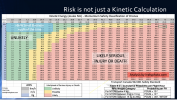I didn't argue that this task force tackled the risk to manned aviation. Is that all you are offended by
I'm not offended, and neither should you be.
This thread was discussing terminal velocity. I posted a link to the FAA report wherein they calculated terminal velocity, and used those questionable results to give birth to the now near-universally accepted and copied 250 gram threshold.
I am critical of the methodology used to arrived at that number. The math seems valid enough, but I'm skeptical of the shaky assumptions used as inputs to those equations.
At the time, the FAA held press conferences proudly touting their new drone registration requirements as something that would somehow prevent the bad guys from doing dumb things with drones. And yet there has never been any evidence to demonstrate that registration has ever served any useful purpose whatsoever, other than as a source of taxation.
Sure, the FAA, and Transport Canada, and EASA, and CASA, and everybody else, all later introduced many more restrictions which actually do attempt to influence how UAS can safely co-exist with manned aviation.
But this terminal velocity calculation used by the Registration Task Force was only ever intended to apply to the registration process. And it ONLY addressed the hazard to people on the ground. Instead that number is now used as the Gospel around the world for distinguishing between sub-250 gram drones considered to be safe enough to be ignored, versus 250g-25kg being dangerous enough to require ever stricter regulation.
And the entire time that 250 gram number was generated out of thin air by the Registration Task Force using assumptions pulled out of thin air. No actual test data, no valid risk analysis, nothing at all. It's just become accepted that 250 grams is somehow a sensible threshold.
Based on their numbers, in November 2015 the task force predicted,
"
1 ground fatality for every 20,000,000 flight hours of an sUAS"
How many ground fatalities have been caused by 250 gram drones? Or, how many due to drone heavier than 250 grams?
I really don't understand your almost rabid anti-FAA response to everything they do.
I'm equally rabid about many of the things done by Transport Canada. For example, the same 250 gram threshold is used in our regulations, with never an explanation or justification provided for the choice of that number. We simply copied it directly from your FAA. There's no denying where it came from.












